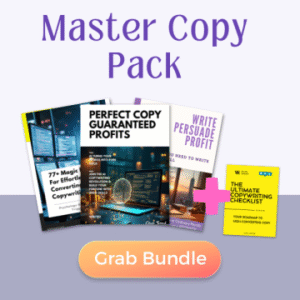Look, I get it. You’re staring at a blank page wondering why your copy sounds like a robot wrote it. I’ve been there—trust me, my first sales email was so bad it probably made people unsubscribe from the internet entirely. But here’s the thing: the best tips to improve copywriting for beginners aren’t some secret sauce only the pros know. They’re simple, practical strategies you can start using today.
After mentoring dozens of entry-level marketers, I’ve noticed the same patterns. Most beginners overthink it. They try to sound fancy when simple works better. They write for everyone instead of someone specific. And they forget that good copy is just good conversation on paper.
Ready to transform your copy from “meh” to “hell yes”? Let’s dive in.
Start With Your Reader’s Brain (Not Your Product Features)
Your audience doesn’t care about your product’s 47 features. They care about one thing: what’s in it for them?
I learned this the hard way when I wrote a landing page for a project management tool. I listed every feature imaginable. The result? Cricket sounds. Then I rewrote it focusing on one benefit: “Never miss another deadline.” Conversions jumped 340%.
Here’s how to flip the switch:
• Write down your product’s top 3 features • For each feature, ask “So what?” three times • Turn your final answer into a benefit statement • Lead with the benefit, mention the feature second
The “So What?” Method in Action
Feature: “Our software has automated scheduling.”
- So what? It saves time.
- So what? You don’t have to manually schedule meetings.
- So what? You can focus on actual work instead of calendar tetris.
Benefit: “Focus on work that matters while we handle your calendar chaos.”
Related articles:
- How to Improve Copywriting Skills “The No-BS Guide”
- Improve Copywriting Website: 12 Tips for Better Conversions
- Copywriting Exercises to Improve Writing
- Improve Copywriting: 12 Fast Wins That Actually Work
Write Like You’re Talking to Your Best Friend
Corporate speak kills conversions. Period.
Instead of writing like you’re addressing a boardroom, write like you’re explaining something to a friend over coffee. Use contractions. Ask questions. Share stories. Be human.
Here’s what I mean:
Corporate speak: “Our innovative solution leverages cutting-edge technology to optimize your workflow efficiency.”
Human speak: “We built this tool because spreadsheets are soul-crushing, and you deserve better.”
See the difference? The second version connects. The first one puts people to sleep.
Simple Swaps That Work
• Replace “utilize” with “use” • Replace “in order to” with “to” • Replace “facilitate” with “help” • Replace “prior to” with “before”
Hook Them Hard in the First 5 Seconds
Your opening line is make-or-break territory. Most people decide whether to keep reading in 5 seconds or less.
Skip the fluff. Skip the “Welcome to our website” nonsense. Jump straight into their world with a problem they recognize.
Bad opening: “ABC Company has been a leader in innovative solutions since 1995.”
Good opening: “Your inbox is a disaster zone, and your team keeps missing deadlines.”
The good opening hits you in the gut because it’s probably true. The bad opening? Who cares when you started your company?
5 Opening Line Formulas That Work
• The Problem Hook: “Your [problem] is costing you [consequence].” • The Question Hook: “What if I told you [surprising claim]?” • The Story Hook: “Last Tuesday, I watched [specific scenario]…” • The Statistic Hook: “[Number]% of [audience] struggle with [problem].” • The Bold Statement Hook: “[Controversial opinion about industry].”
Use Power Words That Trigger Action
Some words are lazy. Others work overtime.
Words like “good,” “nice,” and “great” are wallflowers at the conversion party. They show up but don’t do anything. Power words? They’re the life of the party.
Instead of: “Our product is good for busy professionals.” Try: “Our product saves overwhelmed professionals 3 hours per week.”
“Saves” and “overwhelmed” hit harder than “good” and “busy.” They paint a clearer picture and create urgency.
20 Power Words for Beginner Copywriters
• Instant (immediate gratification) • Proven (removes doubt) • Effortless (promises ease) • Guaranteed (reduces risk) • Exclusive (creates scarcity) • Behind-the-scenes (satisfies curiosity) • Step-by-step (makes it manageable) • Mistakes (triggers fear of missing out) • Secrets (implies insider knowledge) • Breakthrough (suggests innovation)
But here’s the catch—don’t stuff these words everywhere. Use them strategically where they naturally fit.
Master the Art of Specific Details
Vague copy is forgettable copy. Specific copy sticks like glue.
Don’t say “many customers.” Say “847 customers.” Don’t say “quickly.” Say “in 15 minutes.” Don’t say “affordable.” Say “for less than your daily coffee budget.”
I once A/B tested two subject lines:
- Version A: “Increase your productivity”
- Version B: “Save 2.5 hours every Tuesday”
Version B won by 67%. Why? Because 2.5 hours on Tuesday is specific and believable. “Increase productivity” is vague corporate fluff.
The Specificity Checklist
Before you publish, scan your copy for these vague culprits:
• Many → Replace with exact numbers • Soon → Replace with specific timeframes • Affordable → Replace with actual prices • Easy → Replace with specific actions • Popular → Replace with concrete proof
Write Headlines That Stop the Scroll
Your headline is your first impression. Make it count.
Most beginners write headlines for search engines, not humans. Big mistake. Write for humans first, then optimize for search. A headline that doesn’t grab attention won’t get clicked, even if it ranks #1.
The 4 U’s Formula
Every great headline includes:
• Urgent (time-sensitive) • Unique (stands out) • Ultra-specific (crystal clear) • Useful (valuable)
Before: “Tips for Better Email Marketing” After: “7 Email Subject Lines That Boosted Our Open Rates 43% This Month”
The “after” version hits all four U’s. It’s urgent (this month), unique (specific percentage), ultra-specific (7 subject lines), and useful (boosts open rates).
Edit Like Your Life Depends on It
First drafts are supposed to suck. That’s why they’re called first drafts.
The magic happens in editing. I probably spend 70% of my time rewriting and polishing. Here’s my process:
Round 1: Get the ideas down. Don’t worry about perfection. Round 2: Cut the fluff. If it doesn’t move the story forward, it goes. Round 3: Punch up the language. Replace weak words with strong ones. Round 4: Read it aloud. If you stumble, your readers will too.
The 24-Hour Rule
Never publish copy the same day you write it. Let it sit overnight. Come back with fresh eyes. You’ll spot problems you missed the first time.
I still cringe at some copy I rushed to publish. Don’t be me. Take the extra day.
Test Everything (Even the Weird Stuff)
Your opinion doesn’t matter. Your audience’s response does.
I once tested a headline that I thought was terrible. It outperformed my “brilliant” version by 89%. The lesson? Your gut feeling isn’t always right.
Test these elements:
• Headlines (biggest impact) • Opening lines (second biggest) • Call-to-action buttons (color and text) • Email subject lines (easy wins) • Value propositions (core message)
Start with simple A/B tests. Change one element at a time. Let the data decide what works.
What to Test First
If you’re new to testing, start here:
- Headlines – biggest potential impact
- CTA button text – “Buy Now” vs “Get Started”
- Email subject lines – easy to test, quick results
- Opening paragraphs – hook improvement
- Value propositions – core message clarity
FAQ: Common Copywriting Questions from Beginners
Q: How long should my copy be? A: Long enough to convince, short enough to hold attention. For landing pages, test both long and short versions. For emails, keep it under 200 words unless you’re telling a story.
Q: Should I use humor in my copy? A: Only if it fits your brand and audience. B2B software? Probably not. Casual lifestyle brand? Maybe. Test it, but don’t force it.
Q: How often should I use my target keyword? A: Naturally. If you’re forcing it, your readers will notice. Focus on writing for humans first, then check if your keyword appears naturally throughout.
Q: What’s the biggest mistake beginners make? A: Writing for everyone instead of someone specific. Pick one person and write directly to them. Your copy will instantly sound more conversational and compelling.
Q: How do I know if my copy is working? A: Track your metrics. Click-through rates, conversion rates, open rates—whatever matters for your goal. If numbers go up, it’s working. If not, keep testing.
Q: Should I hire a professional copywriter? A: Eventually, yes. But start by learning the basics yourself. You’ll become a better client and understand what good copy looks like.
Your Next Steps to Copywriting Success
The best tips to improve copywriting for beginners boil down to this: write like a human, focus on benefits, be specific, and test everything.
Start with one tip from this guide. Maybe it’s writing more specific headlines. Maybe it’s using the “So What?” method to find better benefits. Pick one thing and practice it for a week.
Then add another tip. Layer them together. In three months, you’ll look back at your old copy and cringe—but that’s good. It means you’re growing.
Copy is a skill, not a talent. The more you practice these best tips to improve copywriting for beginners, the better you’ll get. And better copy means better results for your business.
Ready to transform your copy? Pick your first tip and start writing. Your future self (and your conversion rates) will thank you.
Remember: every expert was once a beginner. The only difference between you and them? They kept writing, kept testing, and kept improving. Your turn.

